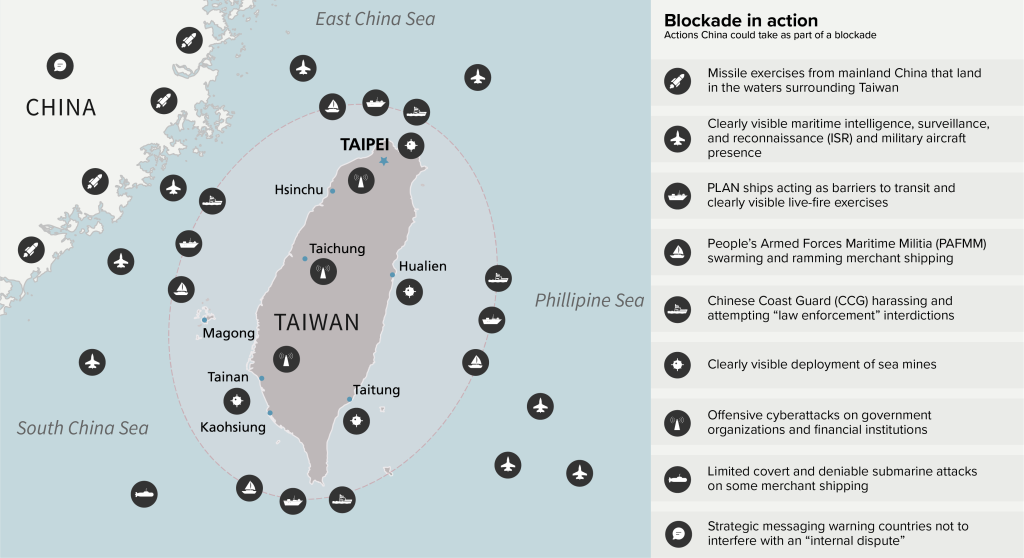A maritime blockade of Taiwan by the People’s Republic of China: A strategy to defeat fear and coercion
FORWARD DEFENSE
STRATEGY PAPER LAUNCH
The United States faces an increasingly challenging international security environment with ongoing conflicts in Europe and the Middle East. Tensions are also rising across the Taiwan Strait. With Xi Jinping charging his military to give him the ability to invade Taiwan by 2027, US and allied defense strategists are rightly concerned about a military contingency in the Taiwan Strait. Yet, while an invasion poses the greatest threat to Taiwan’s sovereignty, a naval blockade might be the most viable option for China.
In this installment of the Atlantic Council Strategy Papers Series, 2022-2023 Senior US Navy Fellow Marek Jestrab articulates a vision to prevent and, if needed, defeat a maritime blockade of Taiwan by China. This strategy paper demonstrates that a maritime blockade is the most strategically viable action for the PRC, that Taiwan is uniquely vulnerable to a blockade, and that a blockade is both a present and enduring challenge. The author presents specific actions for Taiwan, the United States, and like-minded nations with the goal of deterring and, if deterrence fails, defeating a PRC blockade of Taiwan.
The only predictable element of warfare is that it is inherently unpredictable; a near-singular focus on a Chinese invasion by force risks catching the Taiwanese, US, and likeminded militaries unprepared in the event of a non-kinetic naval blockade.
Stephen J. Hadley, 20th National Security Advisor
Executive summary
Blockade: The most strategically viable option for the PRC
The People’s Republic of China’s intention to unify Taiwan with the mainland is clear. Leveraging decades of sustained military modernization, the PRC possesses the capability and regional overmatch of maritime capacity required to execute a blockade of Taiwan. The specific actions that the PRC could execute will be discussed as part of this paper, but the term “blockade” in the context of this strategy refers to the PRC using coercive actions to prevent merchant shipping from having freedom of navigation in the waters surrounding Taiwan, and sealing off Taiwan’s seaports to prevent merchant shipping from being able to enter or exit the island.
A blockade is the most likely and dangerous scenario, due to Taiwan’s reliance on maritime trade to sustain its economic prosperity. Moreover, a nonkinetic blockade is appealing to the PRC, as it is the lowest level of coercive action that could remain below the threshold of open hostilities and still achieve its national objectives. The PRC’s maritime threat would be a coercive act, designed to instill fear in the Taiwanese population and the merchant shipping industry.
The PRC views the existence of Taiwan as a direct threat to its national sovereignty. Because of these perceived threats, the strategic plans of the PRC call for resolution of the “Taiwan question” before China is able to achieve its desired “national rejuvenation” by 2049. To accomplish this goal, the PRC refuses to renounce the use of force to compel unification of Taiwan with the mainland.
Additionally, the Russia-Ukraine war has made clear that unprovoked invasions of neighboring countries are simple for the world population to understand, and for leaders to rally against. Unlike an invasion, a blockade does not present the same strategic-messaging flaws. Moreover, the PRC’s military strategy indicates an openness to blockades and other uses of “restraint warfare,” which the People’s Liberation Army (PLA) defines as seeking to avoid war first through military preparedness and powerful conventional and strategic forces that act in concert with political and diplomatic efforts to “subdue enemy’s forces without fighting.”1“2023 Report on Military and Security Developments Involving the People’s Republic of China,” US Department of Defense (DOD), October 19, 202, https://media.defense.gov/2023/Oct/19/2003323409/-1/-1/1/2023-MILITARY-AND-SECURITY-DEVELOPMENTS-INVOLVING-THE-PEOPLES-REPUBLIC-OF-CHINA.PDF.
All these factors point to a maritime blockade of Taiwan as the PRC’s most strategically viable option. Therefore, what is required is a strategy specifically tailored to deterring and, if deterrence fails, defeating a PRC maritime blockade of Taiwan. The major elements of this strategy include Taiwan investing in capabilities that help demonstrate the resilience to resist, the United States maintaining the capability to sustain Taiwan in the face of a blockade, and like-minded nations providing enabling capabilities and additional maritime capacity.
The focus of this paper is on a nonkinetic blockade, but it is worth noting that there are multiple scenarios in which the PRC could utilize maritime advantages in its attempt to unify Taiwan with the mainland. A fundamental challenge of these actions is that the PRC can dynamically scale the operations based on evolving conditions.
Potential blockade scenarios
- Kinetic blockade: Focusing effort only on the maritime domain, and the merchant shipping that is vital to sustaining Taiwan’s economic activity, the PRC could attack to sink or disable any merchant ship transiting to Taiwan—clearly constituting an act or acts of war. A coalition response would utilize the same forces that would be vital to countering an invasion scenario and PRC maritime forces. These include long-range precision fires from land-based missile batteries, standoff attacks by aircraft and surface ships, and undersea attacks from submarines. Comprehensive missile-defeat capabilities in the space, cyber, and electronic-warfare domains would also need to be employed to assist in the survivability of merchant shipping.
- Nonkinetic blockade: In this scenario, which is the focus of this paper, the PRC would use advantages of mass—enabled by having the world’s largest navy and coast guard, and a government-funded and government-controlled maritime militia—to prevent merchant shipping from entering ports in Taiwan. The PRC has used these tactics on a smaller scale in disputed maritime areas in the South China Sea.
- Sporadic and tailored blockade: Utilizing some combination of the kinetic and nonkinetic actions described in this paper, the PRC could slowly erode Taiwan’s will to resist and that of like-minded nations. The PRC could conduct this effort over a longer period that is deliberately unpredictable. The merchant-shipping industry might evaluate the waters around Taiwan as unsafe and disputed, in turn causing insurance-premium increases that prevent the business case for continuing to sail merchant ships to and from Taiwan’s maritime ports.
- Embargo/quarantine: The PRC could utilize its maritime forces to attempt to enforce an “embargo” that would prevent certain products from entering Taiwan. The PRC would leverage its success at shutting out Taiwan from international organizations, claiming the action as a “domestic matter” and no concern of the international community. Utilizing the world’s largest coast guard, the PRC would inspect merchant ships transiting to Taiwan or force them to divert to the mainland.
While there is no consensus on a perfect term to describe the possible coercive actions that the PRC could employ in the maritime domain, “blockade” is utilized in this paper as it is the best available and most wildly understood term.2Bradley Martin et al., “Implications of a Coercive Quarantine of Taiwan by the People’s Republic of China,” RAND Corp., 2022, https://www.rand.org/pubs/research_reports/RRA1279-1.html.
This paper puts forth a strategy to prevent and, if needed, defeat a PRC blockade of Taiwan. This is consistent with the US government’s existing One China Policy, with a legal basis grounded in the Taiwan Relations Act of 1979, the US-PRC Joint Communiques of 1972, 1978, and 1982, and President Ronald Reagan’s Six Assurances to Taiwan of 1982.3 Susan V. Lawrence and Caitlin Campbell, “Taiwan: Political and Security Issues,” Congressional Research Service, April 26, 2023, https://crsreports.congress.gov/product/pdf/IF/IF10275.
What is required is a strategy specifically tailored to deterring and, if deterrence fails, defeating a PRC maritime blockade of Taiwan.
Commander Marek Jestrab, Academic Year 2022-23 Senior US Navy Fellow
Taiwan’s unique vulnerability to blockade
The PRC today possesses the maritime force structure needed for regional overmatch in a blockade scenario. The Chinese Communist Party (CCP) commands the world’s largest navy, the world’s largest coast guard, and a massive government-subsidized maritime militia. From 2005 to 2022, the People’s Liberation Army Navy (PLAN) has added 135 ships to its inventory, while in the same period the US Navy added just two.4Ronald O’Rourke, “China Naval Modernization: Implications for U.S. Navy Capabilities—Background and Issues for Congress,” Congressional Research Service, May 15, 2023, https://crsreports.congress.gov/product/pdf/RL/RL33153/267.
Located only one hundred nautical miles from mainland China, Taiwan is uniquely vulnerable to a blockade. Taiwan’s dependence on maritime trade is evidenced by the imbalance of its gross domestic product (GDP) in relation to its port activity: Taiwan is the world’s twenty-first largest economy by GDP, yet requires the world’s sixth greatest number of port calls by container ships to sustain this level of economic activity. Taiwan’s largest vulnerability is its energy sector, as it relies on maritime trade to import nearly 98 percent of its energy.
PRC coercive actions in a maritime blockade of Taiwan
A PRC nonkinetic blockade of Taiwan would consist of a series of coercive actions that are uniquely scalable, and even reversible if the CCP does not believe they will be successful at that time. The goal of these coercive actions would be to create fear of maritime shipping and urge the Taiwan population to force negotiations in which the PRC has maximum leverage over Taiwan. A nonkinetic blockade by the PRC would likely include:
- Strategic messaging to warn countries against interfering in an “internal dispute”;
- Clearly visible maritime intelligence, surveillance, and reconnaissance (ISR) and military aircraft presence;
- People’s Armed Forces Maritime Militia (PAFMM) swarming and ramming merchant shipping;
- Chinese Coast Guard (CCG) harassing and attempting “law-enforcement” interdictions;
- PLAN ships acting as barriers to transit and clearly visible live-fire exercises;
- Offensive cyberattacks on government organizations and financial institutions;
- Severing or holding at risk undersea cables that connect Taiwan to the world;
- Missile exercises from mainland China that land in the waters surrounding Taiwan;
- Clearly visible deployment of sea mines; and
- Limited covert and deniable submarine attacks on merchant shipping.
Counter-blockade response by Taiwan and the United States
A coalition response coordinated among Taiwan, the United States, and like–minded nations would be needed to restore deterrence. The desired end state would demonstrate the ability to sustain Taiwan’s economy indefinitely in the face of a PRC blockade. Senior leaders of the coalition would likely seek response options that manage the horizontal and vertical escalation of the conflict. Counter blockade actions by Taiwan, the United States, and like-minded nations would likely include:
- Condemnation through coordinated strategic messaging, with a focus on the harm caused by the PRC’s actions to the global economy;
- Taiwan demonstrating resilience and a will to resist, through implementing resource-rationing programs and reserve-force mobilization;
- Targeted sanctions against the PRC that limit its access to global financial markets and critical technology;
- Maritime ISR being continuously deployed to document the PRC’s actions;
- Reflagging of merchant shipping to coalition national flags that the PRC would be hesitant to attack;
- Escort of merchant shipping through the PRC forces by coalition naval warships;
- Mine countermeasure forces identifying minefields for merchant shipping to avoid; and
- Defensive cyber operations.

Actions to defeat the fear and coercion of a PRC Blockade
Deterring the PRC from even attempting a blockade requires a strategy that communicates to the PRC that its attempted coercive act would fail and prove to be a grave miscalculation. To communicate this message, an international coalition is required that can demonstrate the capability, ability, and will to sustain Taiwan’s economy indefinitely if it were confronted with a blockade. Implementing this strategy would require that:
- Taiwan demonstrate the resilience to resist;
- The United States demonstrate the capability to respond; and
- Like-minded nations demonstrate enabling capabilities and maritime capacity.
To read the full strategy paper, download the PDF.
Strategy Paper Editorial board
Executive editors
Frederick Kempe
Alexander V. Mirtchev
Editor-in-chief
Matthew Kroenig
Managing Editor
Andrew A. Michta
Editorial board members
James L. Jones
Odeh Aburdene
Paula Dobriansky
Stephen J. Hadley
Jane Holl Lute
Ginny Mulberger
Stephanie Murphy
Dan Poneman
Arnold Punaro
Lead author
This strategy paper contains the author’s personal views, and do not represent official positions of the US Navy or Department of Defense.
The author would like to thank Matthew Kroenig, Clementine Starling, Markus Garlauskas, Joseph Webster, and Kitsch Liao for their review and feedback. The author would also like to thank Julia Siegel and Shreya Lad for their editing and administrative support.
With a Foreword by

Forward Defense, housed within the Scowcroft Center for Strategy and Security, generates ideas and connects stakeholders in the defense ecosystem to promote an enduring military advantage for the United States, its allies, and partners. Our work identifies the defense strategies, capabilities, and resources the United States needs to deter and, if necessary, prevail in future conflict.
Image: Ships in a Storm on a Rocky Coast, Jan Porcellis, Wikimedia Commons.

